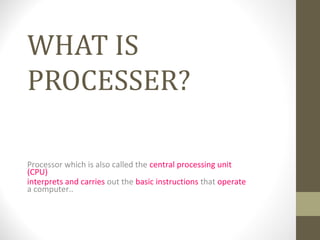System Unit
•Als PPT, PDF herunterladen•
0 gefällt mir•646 views
System, computer, unit
Melden
Teilen
Melden
Teilen

Empfohlen
Empfohlen
Weitere ähnliche Inhalte
Was ist angesagt?
Was ist angesagt? (20)
CPU-Central Processing Unit (With History and Complete Detail)

CPU-Central Processing Unit (With History and Complete Detail)
CSC1100 - Chapter02 - Components of the System Unit

CSC1100 - Chapter02 - Components of the System Unit
Computer Organization: Introduction to Microprocessor and Microcontroller

Computer Organization: Introduction to Microprocessor and Microcontroller
Ähnlich wie System Unit
Ähnlich wie System Unit (20)
fundamentals of digital communication unit 2 notes.pdf

fundamentals of digital communication unit 2 notes.pdf
Mehr von chrispaul8676
Mehr von chrispaul8676 (15)
Kürzlich hochgeladen
https://app.box.com/s/7hlvjxjalkrik7fb082xx3jk7xd7liz3TỔNG ÔN TẬP THI VÀO LỚP 10 MÔN TIẾNG ANH NĂM HỌC 2023 - 2024 CÓ ĐÁP ÁN (NGỮ Â...

TỔNG ÔN TẬP THI VÀO LỚP 10 MÔN TIẾNG ANH NĂM HỌC 2023 - 2024 CÓ ĐÁP ÁN (NGỮ Â...Nguyen Thanh Tu Collection
Mehran University Newsletter is a Quarterly Publication from Public Relations OfficeMehran University Newsletter Vol-X, Issue-I, 2024

Mehran University Newsletter Vol-X, Issue-I, 2024Mehran University of Engineering & Technology, Jamshoro
Kürzlich hochgeladen (20)
Asian American Pacific Islander Month DDSD 2024.pptx

Asian American Pacific Islander Month DDSD 2024.pptx
Micro-Scholarship, What it is, How can it help me.pdf

Micro-Scholarship, What it is, How can it help me.pdf
Unit-V; Pricing (Pharma Marketing Management).pptx

Unit-V; Pricing (Pharma Marketing Management).pptx
Unit-IV; Professional Sales Representative (PSR).pptx

Unit-IV; Professional Sales Representative (PSR).pptx
Z Score,T Score, Percential Rank and Box Plot Graph

Z Score,T Score, Percential Rank and Box Plot Graph
Food Chain and Food Web (Ecosystem) EVS, B. Pharmacy 1st Year, Sem-II

Food Chain and Food Web (Ecosystem) EVS, B. Pharmacy 1st Year, Sem-II
TỔNG ÔN TẬP THI VÀO LỚP 10 MÔN TIẾNG ANH NĂM HỌC 2023 - 2024 CÓ ĐÁP ÁN (NGỮ Â...

TỔNG ÔN TẬP THI VÀO LỚP 10 MÔN TIẾNG ANH NĂM HỌC 2023 - 2024 CÓ ĐÁP ÁN (NGỮ Â...
ICT role in 21st century education and it's challenges.

ICT role in 21st century education and it's challenges.
Python Notes for mca i year students osmania university.docx

Python Notes for mca i year students osmania university.docx
System Unit
- 1. WHAT IS PROCESSER? Processor which is also called the central processing unit (CPU) interprets and carries out the basic instructions that operate a computer..
- 2. • The operating system views each processor as a separate processor. multi-core processor ɷ it is a processor with a single chip with two or more separate processor cores.
- 3. THE COMMON MULTI-CORE PROCESSOR ARE DUAL- CORE AND QUAD-CORE. • A dual-core processor is a chip that contains TWO separate processor cores. • A quad-core processor is a chip with FOUR separate processor cores.
- 4. When a user starts a program, for example its instruction transfer from a storage device to memory. Data needed by programs enters memory from either an input device or a storage device.The control unit interprets in memory and ALU performs calculation the data in memory. Resulting information is stored in memory for future access... INPUT DEVICES ↓ data MEMORY ↓ information OUT DEVICES
- 5. • Processors contain a control unit and an arithematic logic unit (ALU). • These two components work together to perform processing operations.
- 6. THE CONTROL UNIT • Is the component of the processor that directs and coordinates most of the operations in the computer. • It interprets each instruction issued by a program and then initiates the appropriate action to carry out instruction.
- 7. • There are a few types of internal components that control units direct such as: a) arithematic logic unit b) registers c) buses
- 8. Parallel processing • is a method that uses multiple processors simultaneously to execute a single program or task • it divides a single problem into portion so that multiple processor work on their assigned portion of the problem at the same time.
- 9. • These are the few examples of a processor:
- 10. MEMORY • It consists of electronic components that store instructions waiting to be executed by the processor. • The role of memory is to store both data and programs which is known as the stored programs concept.
- 11. • Memory stores three basic categories items: a) the operating system and other system software that controls or maintain the computer and its devices. b) application programs that carry out a specific task such as word processing c) the data being proccesed by the application programs and resulting information.
- 12. Bytes and Addressable Memory • A byte (character) is the basic storage unit in memory. • The data are transferred to memory from storage devices where the instructions and data exsist as bytes. • Each byte resides temporarily in a location in memory that has a address.
- 13. Types Of Memory • There are two types of memory: a) volatile b) non-volatile
- 14. • When the computer's power is turned off volatile memory loses its contents. • Non-volatile, by contrast, does not loses its contents when the power is removed from the computer. • Thus, volatile memory is temporary and non- volatile memory is permenant. • RAM is the most common type of volatile memory.
- 15. • Examples of non-volatile include ROM, flash memory, and CMOS. • These are the few examples of memory: